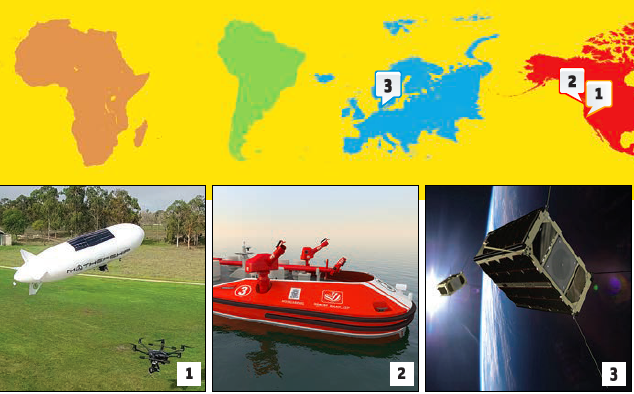1. Pipeline Inspecting Blimp
South San Francisco, California
Mothership Aeronautics is using autonomous solar-powered blimps to disrupt long-distance aerial data collection. The TerraSoar Aerial Intelligence Airship features a powerful combination of lighter-than-air lifting and high efficiency solar cells that enable higher endurance and longer-range flights than possible with drones, while also operating heavy payloads like LiDAR.
The name, TerraSoar, stems from a family of prehistoric flying reptiles. The Pterosaurs were the first vertebrates known to take to the clouds just as the TerraSoar is the first blimp-type drone to hit the drone inspection market and Mothership Aeronautics’ first Aerial Intelligence Craft.
2. Remote Control Fireboats
<em?>Vancouver, British Columbia, Canada
To address the evolving safety and security needs of modern ports, Vancouver-based naval architects and marine engineers Robert Allan Ltd., and international marine technology specialist Kongsberg Maritime are collaborating on the development of a radically new remotely-operated fireboat that will allow first responders to attack dangerous port fires more aggressively and safer than ever before.
The Kongsberg Maritime control & communications system will feature a robust high-bandwidth, low latency wireless link to a semi-portable RALamander operator console that can be located on a manned fireboat, or other vessel of opportunity such as a tug boat or pilot boat. In common with other KONGSBERG autonomous control systems, the architecture of RALamander’s control system will leave the door open to a range of autonomy levels, which are configurable or future-upgradable to suit the operator or port’s evolving needs.
3. Cereal-Box Satellite
Aalborg, Denmark
The European Space Agency’s first mission of the year, launched in February, was the GomX-4B, the ESA’s most advanced technology-tester yet, featuring a hyperspectral camera and tiny thrusters to maneuver thousands of kilometers from its near-twin to try out their radio link.
These CubeSats are built around standard 10×10 centimeter units by GomSpace in Denmark. As “six-unit” CubeSats they are as big as cereal boxes – but double the size of their predecessor GomX-3, released from the International Space Station in 2015.
“ESA is harnessing CubeSats as a fast, cheap method of testing promising European technologies in orbit,” comments Roger Walker, heading ESA’s technology CubeSat efforts. “Unlike GomX-3, GomX-4B will change its orbit using cold-gas thrusters, opening up the prospect of rapidly deploying future constellations and maintaining their separations, and flying nanosatellites in formations to perform new types of measurements from space.”

Image credits
1. Mothership blimp from the company: Mothership Aeronautics
2. Fireboat from Robert Allan Ltd.
3. Cereal-box satellite from the European Space Agency




